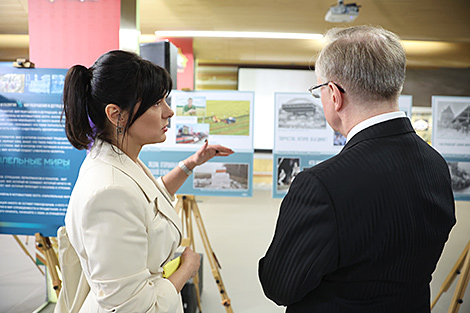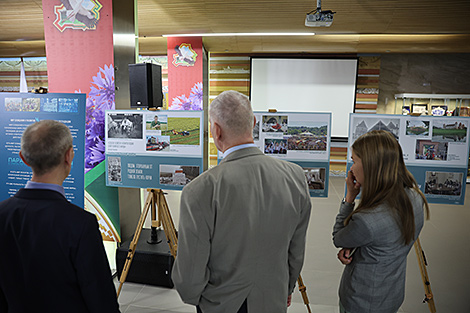Opinions & Interviews
BelTA presents Parallel Worlds exhibition in Moscow

Irina Akulovich. Photo courtesy of TASS
MOSCOW, 17 May (BelTA) - The Belarusian state has its flag in the heart, while the opposition keeps its in the pocket, Director General of the Belarusian news agency BelTA Irina Akulovich made the comparison as she opened BelTA’s exhibition Parallel Worlds in the Business and Cultural Center of the Belarusian Embassy in Russia in Moscow on 16 May.
The exhibition made part of the event to mark the Day of the State Flag, the State Emblem and the National Anthem of Belarus. Irina Akulovich said that BelTA has recently celebrated its 105th anniversary. The agency’s archives contain hundreds of thousands of photos that tell the history of Belarus. “I believe that the Parallel Worlds exhibition is held just at the right time: we honor the emblem, anthem, and flag. This exhibition is about the parallel worlds which live with different symbols: the state has its flag in the heart, while the opposition keeps theirs in the pocket,” she said.
“We made an analysis of the 30-year history of the two worlds: the world of creation is the world of the Belarusian state, and the world of the Belarusian opposition. It is important today also because almost 30 years ago, on 14 May 1995, the first referendum was held in Belarus, where the Belarusians decided how they would live further. As President Aleksandr Lukashenko says, the most important thing is that the people chose this path: strong presidential power, two official languages - Russian and Belarusian, integration with Russia,” BelTA’s director general said.
Irina Akulovich drew the audience's attention to one of the exhibition posters. “This is what was going on in Minsk some 20 years ago and also the recent events and what the Belarusian opposition wanted: no integration. The only thing that the Belarusian opposition wanted with their flag and emblem was no union with Russia. Because no one in the West needs such a union. And because the Belarusian opposition is financed by the West,” she stated.






“The exposition features 18 posters representing an analysis of healthcare, education, culture, industry, economy and other sectors. The state has always created, the state has always worked, while the opposition did nothing but wandered around waving flags and opposing everything. Let us take industry, for example: all the Belarusian opposition wanted in the previous years was to completely destroy the state sector. What would be with our country today if it had been destroyed? The same is true about the agriculture: the opposition wanted us to stop producing harvesters, tractors as it was possible to buy them abroad. What would we have today if we had followed this path? And what we have now thanks to our state and our strong leaders, when there is integration and the ability to resist any economic sanctions,” BelTA director general said.
The exhibition also touches on the topic of the Chernobyl tragedy. “All the opposition did was to rally in the streets for years, calling it Chernobyl Way. All these years the state invested billions to resettle and treat people, to withdraw land from agricultural use and then, making sure it is safe, to put it back in use, to provide children with free meals. Every poster, every topic presents this analysis - the actions of the state and the actions of the opposition,” Irina Akulovich said.
“You can see this huge difference between these two worlds for yourself,” she added.
The Parallel Worlds project features 18 posters which depict the footage from the news agency's archives and documents of the Belarusian State Archive of Cine, Photo and Audio Records. The exhibition was first showcased on the viewing platform of the National Library. The exhibition was visited by more than 8,000 people in a span of five days. Then, the project was on display at Minsk Automobile Plant, Belarusian State University, the Presidential Library of Belarus, and Stolitsa Shopping Mall. Now the exhibition is on show in Russia.







 print version
print version make home page
make home page add to bookmarks
add to bookmarks

